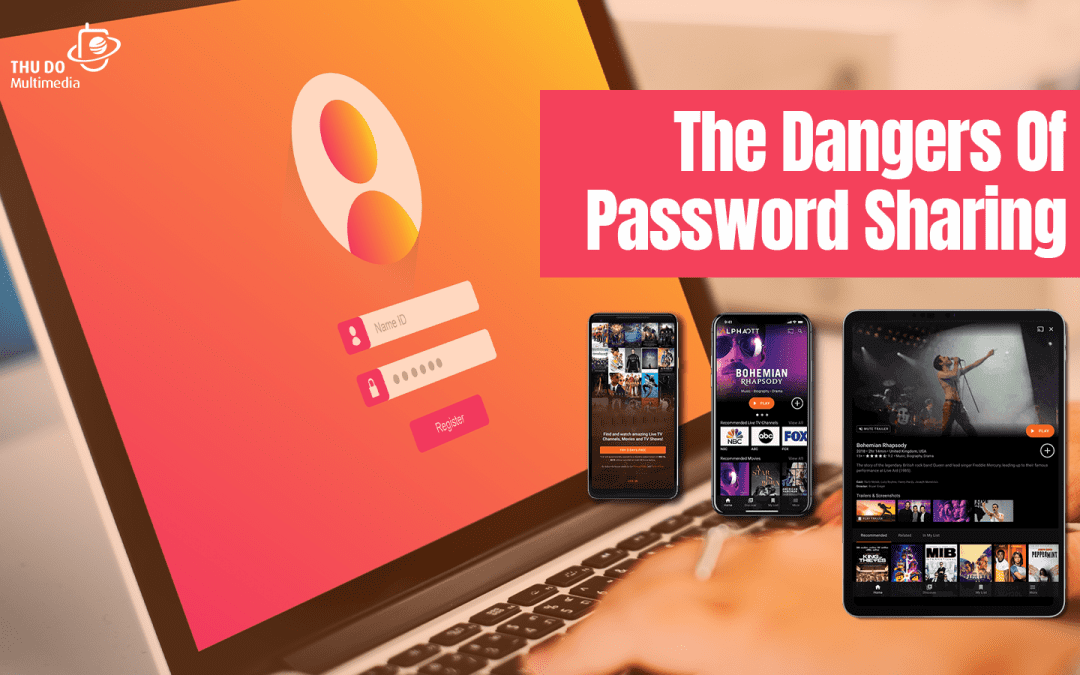In the ever-evolving world of digital entertainment, OTT TV services have become incredibly popular, with many households around the world using them regularly. These platforms give us access to a huge range of content with just a few clicks, including blockbuster movies and original series that people everywhere are loving. In fact, they’re becoming so popular that they’re starting to replace traditional TV for many people.
But as these streaming services grow, there’s a problem that’s starting to emerge: password sharing. It’s something that lots of us do without thinking about it — we share our login details with friends or family members so they can use the service too. But what seems harmless enough can actually cause some big issues for both the companies providing the service and the people using it.
In this article, we’ll take a deep dive into password sharing and its impact on OTT TV services. We’ll look at why people do it, the problems it causes, and what companies are doing to try and stop it. Plus, we’ll explore what this all means for the future of streaming.
So let’s get started and find out how password sharing is changing the world of OTT TV services!
Understanding Password Sharing in the Context of OTT TV Services
OTT TV services, an acronym for “Over-The-Top” Television services, refer to streaming platforms that deliver video content over the internet. These platforms have become a preferred choice for entertainment consumption due to their on-demand nature, extensive content libraries, and the convenience they offer. Viewers can binge-watch their favorite shows at any time, anywhere, without commercials interrupting their experience.
However, with convenience comes challenges – one of which is password sharing. This practice involves multiple users accessing content through a single account by sharing login credentials. It’s like handing out duplicate keys to a prized vault of entertainment; everyone gets access but only one person is paying.
While password sharing might seem harmless or even friendly at first glance, it presents potential drawbacks for both OTT providers and legitimate subscribers:
- For OTT providers, password sharing leads to revenue loss as multiple viewers are entertained for the price of one subscription. It’s akin to several people watching a movie at a cinema but only one ticket being purchased.
- For legitimate subscribers, it may lead to degraded streaming quality if too many people are using the same account simultaneously. Imagine trying to enjoy your favorite show in HD only to have it constantly buffer because someone else is also streaming from your account.
These drawbacks underline the need for attention and action in this area. As we delve deeper into this topic, we’ll explore significant challenges faced by OTT providers due to password sharing and discuss potential solutions.

Challenges Posed by Password Sharing for OTT Providers
Password sharing presents several formidable challenges for OTT providers, impacting their business at multiple levels. Here are the key issues that arise from this practice:
Revenue Loss
- Subscription Evasion: When users share passwords, they effectively bypass the need for individual subscriptions, leading to a direct loss in potential revenue.
- Diluted Customer Value: The more individuals use a single subscription, the less valuable each user becomes in terms of revenue contribution.
- Impaired Growth Metrics: User growth statistics are skewed because multiple viewers appear as a single subscriber, complicating accurate market analysis and forecasting.
Compromised User Experience
- Overburdened Infrastructure: An influx of non-paying viewers can strain server resources, potentially degrading streaming quality for paying subscribers.
- Content Curation Challenges: Shared accounts generate mixed viewing data, which can muddy personalized recommendations and diminish the user experience.
Security Risks
- Vulnerability to Breaches: Password sharing increases the risk of account takeovers and data breaches, as credentials circulate beyond the original subscriber’s control.
- Legal and Compliance Issues: Handling sensitive user data becomes complex when access points are uncertain, possibly leading to violations of privacy regulations.
Unauthorized account sharing also disrupts monetization models that OTT platforms rely on:
Disruption of Monetization Models
- Subscription Model Strain: With fewer individual accounts being created, the subscription model suffers as revenue per user plummets.
- Ad Revenue Impact: Ad-supported platforms may face inaccuracies in viewer metrics, undermining ad pricing strategies and diminishing advertiser confidence.
By navigating these challenges strategically, OTT providers can look to innovative solutions that safeguard their content and ensure a sustainable platform. Moving forward, tactics to mitigate these risks while accommodating consumer preferences will be a focal point for industry evolution.
Case Study: Impact of Password Sharing on Leading OTT Services
Password sharing has tangible impacts on the bottom lines of key industry players. Let’s delve into some real-life examples from leading OTT services:
Netflix
Once adopting a relatively relaxed stance towards password sharing, Netflix has seen its growth slow down, with estimates suggesting that shared passwords cost the company millions in lost revenue annually. This prompts a strategic shift towards limiting simultaneous streams and exploring account-sharing fees.
Amazon Prime Video
With a vast content library and additional membership perks, Amazon Prime Video also grapples with account sharing. The service actively monitors for suspicious activity and may require verification to maintain account integrity.
Hulu
Recognizing the impact of shared passwords, Hulu limits the number of concurrent streams and personalizes content recommendations to encourage individual subscriptions.
Disney+
Disney+ experienced a surge in subscribers post-launch, but password sharing quickly became an obstacle. The platform enforces user limitations and continuously evaluates measures to curtail account sharing without alienating their audience.
These cases illustrate the pervasive challenge of password sharing across diverse monetization models, prompting OTT services to seek innovative solutions to protect their revenue streams and subscriber base.
Addressing the Password Sharing Challenge with Technology and Strategies
OTT providers are using advanced technology to protect their revenues and improve streaming quality. One effective solution is Digital Rights Management (DRM), a set of tools that control access to content and prevent piracy. Sigma Multi DRM is a leading option in this area, offering strong protection on different platforms and devices.
How Sigma Multi DRM Works
Here’s how Sigma Multi DRM helps prevent password sharing:
- Content Encryption: Sigma Multi DRM uses encryption algorithms to lock content and ensure that only authorized users can view it. This system works smoothly on various devices, balancing security with a seamless viewing experience.
- Platform Compatibility: This solution is designed to work across different streaming platforms, making it easier for OTT providers to implement and manage.
- Robust Security Features: Sigma Multi DRM includes features like license expiration, device binding, and playback restrictions, adding extra layers of security to prevent unauthorized access.
Additional Security Measures
In addition to DRM, OTT platforms are adopting other measures to strengthen security:
- Stream Watermarking: This technology adds an invisible identifier to each video stream, making it possible to trace the source of any leaks or unauthorized sharing. The presence of a watermark can also discourage users from sharing their login details.
- Two-Factor Authentication (2FA): By requiring users to verify their identity through a second factor like a mobile device or email, 2FA makes it much harder for attackers to gain access to accounts even if they have the correct password.
The Benefits of These Approaches
By combining these technologies and strategies, OTT services can effectively address the issue of password sharing:
- Protecting Revenues: Limiting access to only paying subscribers helps ensure that OTT providers receive the full financial benefits of their services.
- Maintaining Quality: By preventing unauthorized access, these measures can reduce the strain on servers during peak times, leading to smoother streaming experiences for legitimate users.
Overall, taking a proactive stance on password sharing not only benefits OTT providers but also contributes to a more secure and enjoyable streaming environment for everyone involved.
The Future of Password Sharing in the OTT Industry
The landscape of OTT services is always changing, and with it, the phenomena of password sharing are expected to undergo significant changes. Anticipating future trends and their subsequent impact is essential for OTT platforms to stay ahead:
Changing Consumer Behaviors
As audiences become more tech-savvy and demand greater flexibility, sharing passwords could see a shift from being a cost-saving tactic to an issue of convenience and access. Personalized viewing experiences and targeted content might influence viewers to opt for individual accounts.
Technological Advancements
Innovations in AI and machine learning could lead to smarter detection systems, making it easier for providers to identify and manage shared accounts without compromising user privacy.
Regulatory Interventions
Governments and regulatory bodies might step in to set boundaries for password sharing, particularly if it continues to significantly affect market revenue. These interventions can reshape the industry’s approach towards account security and user authentication.
The OTT industry must continuously adapt to these dynamics, ensuring that they provide value that resonates with modern viewer expectations while safeguarding their business models.
Conclusion
OTT video providers have faced challenges with password sharing, including revenue loss and compromised security. However, there are also opportunities for innovation and growth in this situation. By taking proactive measures to prevent unauthorized account usage, OTT services can improve user experience and generate more revenue.
Here are the key challenges that need to be addressed:
- Revenue Protection: Finding ways to protect income from subscription and ad-based models.
- Enhanced Security: Strengthening platforms against potential breaches.
- Superior User Experience: Ensuring that legitimate subscribers get the most value from their subscriptions.
And here are some opportunities for improvement:
- Engagement Boost: Creating personalized content and experiences to build customer loyalty.
- Innovative Monetization: Exploring new ways to monetize content that benefit both users and providers.
To tackle these issues, consider using Sigma Multi DRM—a powerful solution designed to protect OTT platforms. By implementing this technology, OTT services can safeguard their content and secure their future, creating a thriving environment for content creators, providers, and viewers alike. Learn more about how Sigma Multi DRM can strengthen your strategy in the ever-changing world of digital entertainment.


Recent Comments